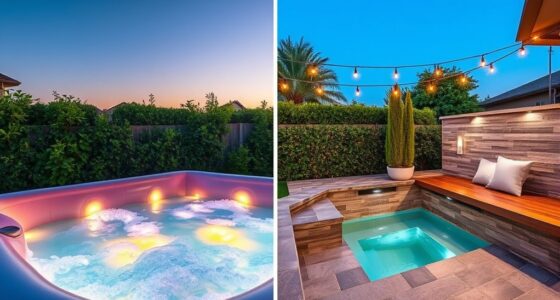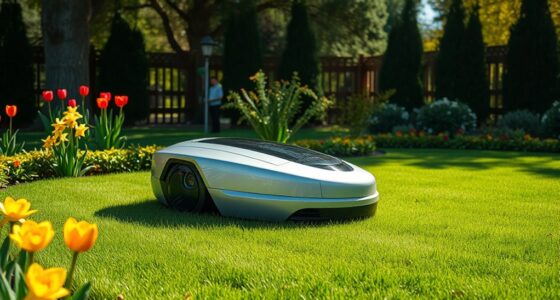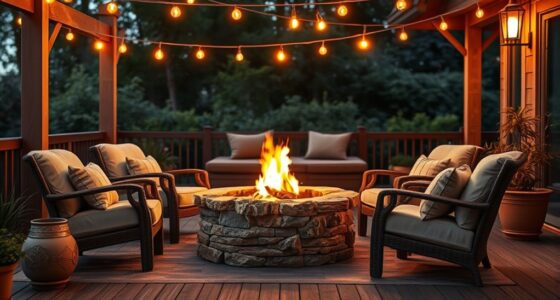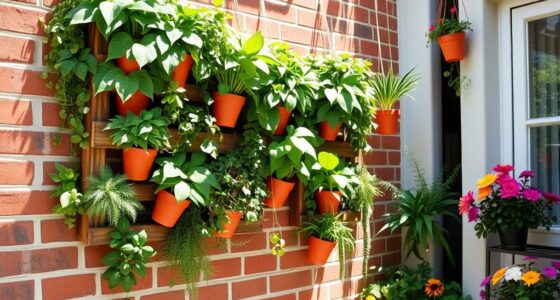Outdoor rugs are definitely worth the hassle if you choose the right material. Polypropylene offers durability, water resistance, and easy maintenance, making it a popular choice. Synthetic options last longer and resist fading better than natural fibers, which require more care. Recycled plastic rugs are eco-friendly and durable too. While some materials need regular cleaning, their style and comfort boost your outdoor space. Keep exploring to find the perfect rug that balances beauty and practicality for your needs.
Key Takeaways
- Durable materials like polypropylene and recycled plastic offer easy maintenance and longevity, reducing ongoing hassle.
- Natural fiber rugs require more care and are prone to mold, making them less practical for outdoor use.
- Synthetic options balance durability with comfort, making outdoor rugs a worthwhile addition for style and function.
- Eco-friendly recycled plastic rugs promote sustainability and tend to withstand outdoor conditions better.
- Proper material selection ensures outdoor rugs are low-maintenance, enhancing their value despite initial effort.
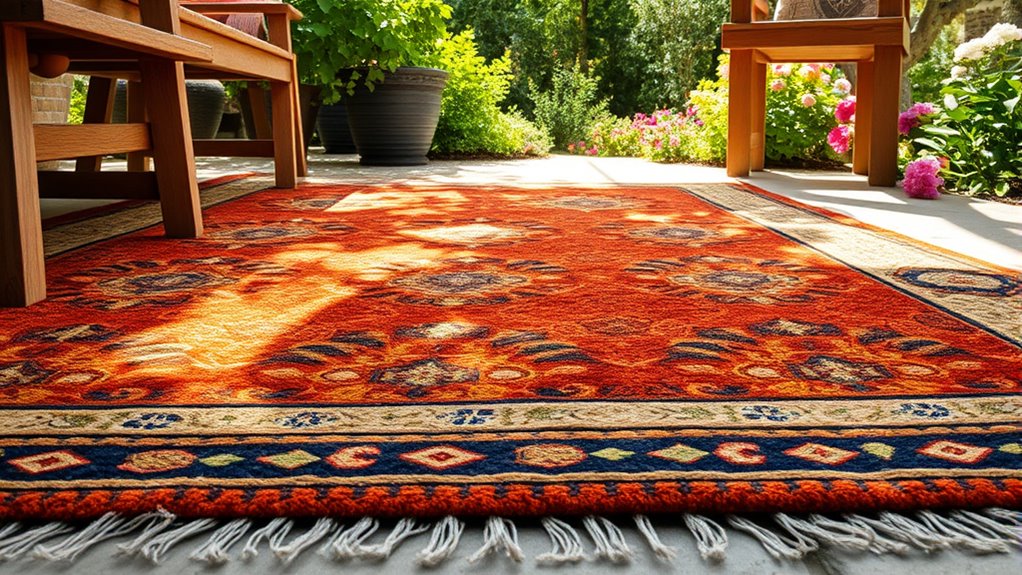
Are you looking to enhance your outdoor space with style and functionality? Outdoor rugs can transform your patio, deck, or balcony into a cozy, inviting area. But before you buy, it’s essential to understand the different materials and what they offer. Knowing which material suits your needs can save you time, effort, and money in the long run.
Polypropylene is the most popular choice for outdoor rugs, and for good reason. It’s incredibly durable, water-resistant, and offers excellent UV protection, meaning it won’t fade quickly under the sun. If you want a rug that can handle rain or splashes from the pool without developing mold or mildew, polypropylene is your best bet. It’s also easy to clean—just hose it down or wipe away stains—and it maintains its appearance over time. Polyester rugs, on the other hand, are known for their vibrant colors and soft texture, making them ideal for covered outdoor areas where moisture isn’t a constant issue. They also resist water well, but they tend to be less resilient than polypropylene.
Polypropylene outdoor rugs are durable, water-resistant, UV protected, and easy to clean, ideal for rain and sun exposure.
Eco-conscious shoppers will appreciate recycled plastic rugs. These are lightweight, water-resistant, fade-resistant, and environmentally friendly, aligning well with sustainable outdoor living. They look good, last long, and require minimal maintenance. Recycled plastic materials are made from used plastic bottles, which helps reduce waste and promotes sustainability. They create a beautiful, natural look, but they’re better suited for covered spaces or areas with minimal exposure to rain and humidity. Additionally, choosing sustainable materials can contribute to conserving natural resources and protecting ecosystems.
Natural fiber options like bamboo, jute, cotton, and wool lend a more natural aesthetic but come with some drawbacks. Jute and cotton, for instance, absorb moisture easily, which can lead to mold or mildew if not dried properly. These materials are also less resistant to UV rays, meaning they fade faster and wear down more quickly outdoors. While they create a beautiful, natural look, they’re better suited for covered spaces or areas with minimal exposure to rain and humidity.
Durability is another critical factor. Polypropylene and polyester rugs rank high in this regard, making them suitable for high-traffic zones. Natural fibers tend to wear out faster, especially in outdoor conditions, and acrylic rugs degrade quickly under sun exposure. When it comes to maintenance, synthetic options like polypropylene are simple—just a quick wash or hose-down keeps them looking fresh. Natural fiber rugs require more attention, often needing careful cleaning and drying to prevent stains and mold. Regardless of material, avoiding prolonged moisture exposure prolongs your rug’s lifespan.
Comfort and texture matter too. Polyester offers a softer, more inviting feel underfoot, perfect for lounging. Synthetic fibers generally balance durability with comfort, allowing your outdoor space to feel both stylish and practical. In the end, the decision depends on your priorities—whether it’s longevity, aesthetics, eco-friendliness, or ease of maintenance. While outdoor rugs require some effort, choosing the right one can make your outdoor area more inviting and functional, making the small hassle worthwhile.
Frequently Asked Questions
How Do Outdoor Rugs Impact Overall Outdoor Space Aesthetics?
Outdoor rugs considerably boost your outdoor space’s aesthetics by adding vibrant colors and textures that make the area more inviting. They help unify your furniture and decor, creating a cohesive look. With bold patterns or neutral hues, you can set the perfect mood for lively gatherings or elegant occasions. Plus, they frame different zones, making your outdoor space feel more organized and visually appealing, enhancing its overall charm and warmth.
Are Outdoor Rugs Environmentally Friendly and Sustainably Sourced?
When considering if outdoor rugs are environmentally friendly and sustainably sourced, you can find options like polypropylene that have a lower environmental impact during production and disposal. Recycled fibers, such as PET plastics, support circular economy efforts. While synthetic rugs are non-biodegradable, their durability reduces waste from frequent replacements. Proper recycling and choosing eco-friendly materials make outdoor rugs a more sustainable choice for your outdoor space.
Can Outdoor Rugs Be Used on Uneven or Rocky Surfaces?
Did you know that over 60% of outdoor rug users report issues on uneven surfaces? You can put outdoor rugs on rocky or uneven grounds, but it’s tricky. Gravel, especially large gravel, can damage rugs or cause discomfort. Using a sturdy rug pad helps secure and protect your rug, while choosing durable materials like polypropylene or open-weave designs improves drainage. Still, surface prep and careful placement are key to making it work.
What Are the Best Maintenance Tips for Outdoor Rugs?
To keep your outdoor rug looking its best, vacuum it weekly on a suction-only setting to remove dirt. Rinse washable rugs with a hose and spot clean stains promptly. Avoid harsh chemicals, and dry the rug thoroughly in sunlight to prevent mildew. Protect it from sun damage by placing it in shaded areas, and secure it with heavy furniture or weights to prevent wind damage. Regular maintenance prolongs its lifespan.
Do Outdoor Rugs Increase the Value of My Property?
You might wonder if outdoor rugs boost your property’s value. While specific data isn’t available, outdoor upgrades like rugs contribute to a 60-80% ROI on patios and outdoor spaces. By enhancing curb appeal and creating inviting outdoor living areas, rugs can make your home more attractive to buyers. They don’t directly increase value but improve overall presentation, potentially leading to quicker sales and higher offers.
Conclusion
Ultimately, outdoor rugs are like a welcome mat for your space, inviting comfort and personality to your outdoor haven. They symbolize a bridge between inside and out, turning bare patios into cozy retreats. While they may bring some upkeep, their charm and warmth make the effort worthwhile. When you roll out that rug, you’re not just covering ground—you’re creating a sanctuary, a rhythm of life and leisure that turns your outdoor space into a reflection of you.


